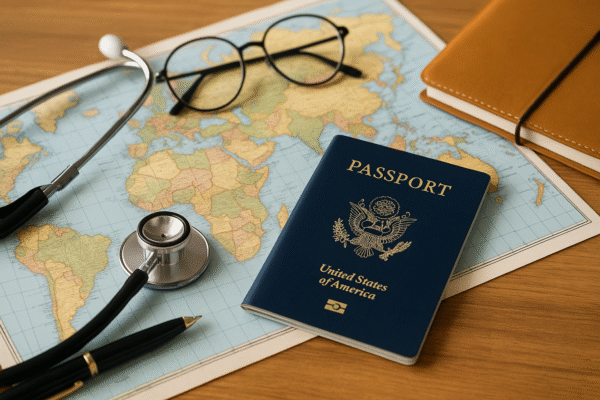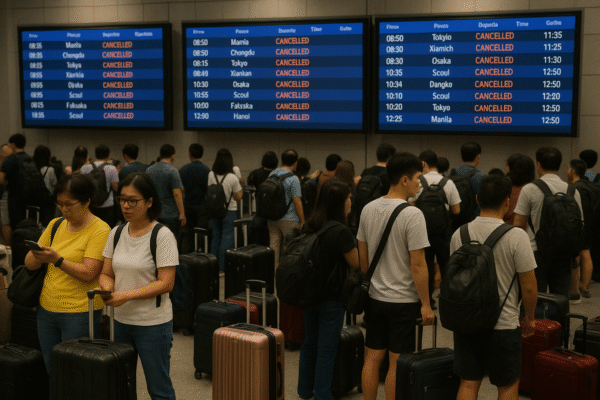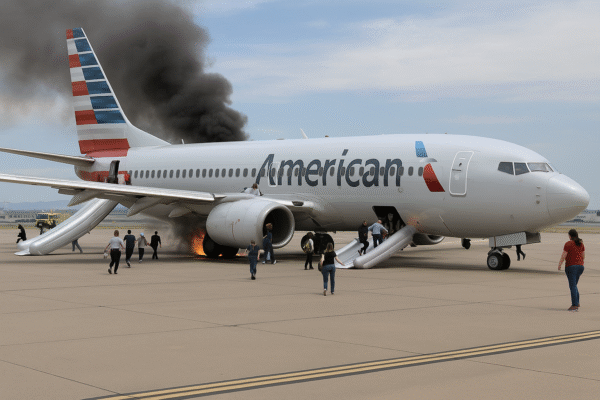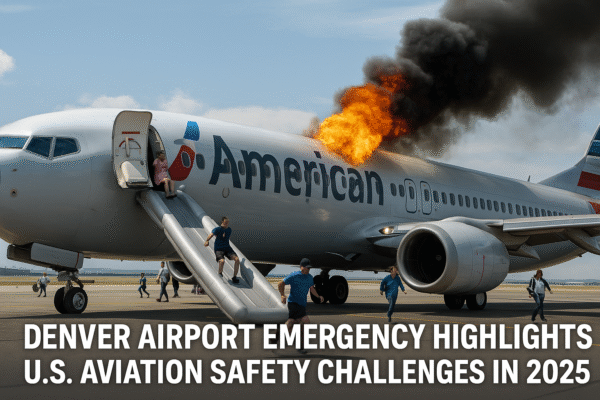Denver, Colorado – July 29, 2025
A major aviation safety incident unfolded at Denver International Airport (DEN) on July 26, 2025, when American Airlines Flight 3023, a Boeing 737 MAX 8, was forced to abort takeoff due to a critical mechanical failure in the landing gear system, triggering a runway fire and full passenger evacuation.
The incident, involving 173 passengers and six crew, reignited national scrutiny over aviation safety protocols in the United States, particularly regarding 737 MAX aircraft reliability, airport emergency preparedness, and public compliance with evacuation procedures.
Smoke, Fire, and Emergency Slides: What Happened on Flight 3023
The Miami-bound flight had just begun accelerating on the runway when a malfunction in the landing gear tire system caused smoke and a small fire to erupt in the braking system.
As panic spread through the cabin, the flight crew aborted the takeoff and initiated an immediate evacuation via emergency slides. Despite urgent instructions to leave personal belongings, several passengers were seen exiting with bags and children in hand, risking evacuation delays and injury.
The Denver Fire Department responded swiftly, extinguishing the fire and containing the scene. According to Denver International Airport officials, one passenger was hospitalized with minor injuries, while five others were treated on-site.
FAA Launches Investigation into Aircraft Fault
The Federal Aviation Administration (FAA) launched a full investigation into the incident, examining the aircraft’s maintenance records and the Boeing 737 MAX 8’s landing gear system.
The agency’s preliminary findings point to tire stress and brake system failure—issues that have prompted broader concerns about fleet maintenance standards amid rising flight volumes post-pandemic.
As part of its probe, the FAA may recommend enhanced inspection cycles for MAX 8 landing gear systems and issue temporary airworthiness directives for affected models across U.S. carriers.
A Troubling Trend: Other Major Aviation Incidents in 2025
Flight 3023 is one of several high-profile aviation incidents in 2025 that have alarmed passengers and regulators alike.
March 13, 2025 – Flight 1006, Denver
A Boeing 737-800 en route from Colorado Springs to Dallas Fort Worth diverted back to DEN after engine vibrations led to a fire upon landing. While all 172 passengers were safely evacuated, 12 sustained minor injuries.
April 15, 2025 – Flight 3506, San Juan
An Airbus A321neo from New York experienced a hard landing at Luis Muñoz Marín International Airport, causing a tire to detach and damaging one engine. The crew safely rerouted the aircraft mid-air, preventing casualties.
These events reflect a growing need for proactive maintenance, real-time flight monitoring, and increased transparency in aircraft performance data.
Why Passenger Behavior Matters in Emergencies
One of the key takeaways from the Flight 3023 incident is the critical role of passenger cooperation during emergencies. Experts emphasize that passengers must:
- Leave all personal belongings behind.
- Follow crew instructions immediately.
- Familiarize themselves with emergency exits during safety briefings.
Delays in evacuation—often caused by passengers retrieving luggage—can increase the risk of injury or worse. According to the FAA, most injuries in runway incidents occur during evacuation delays, not due to fire or impact.
Strengthening Aviation Safety: What the FAA Is Doing
In addition to the investigation, the FAA has committed to bolstering aviation oversight in the following areas:
- Fleet-wide safety audits of Boeing and Airbus aircraft used by U.S. carriers.
- Revised maintenance regulations focused on landing gear systems.
- Stricter monitoring of pilot emergency training and cabin crew preparedness.
- Development of a new Passenger Safety Awareness Campaign in coordination with major airlines.
These measures aim to maintain the U.S.’s reputation as home to one of the safest air travel systems globally.
Changing Airport Protocols and Passenger Expectations
Following the Denver and San Juan incidents, U.S. airports are expected to implement:
- More detailed pre-flight safety inspections.
- Enhanced crew briefings for high-risk aircraft models.
- Improved emergency slide deployment simulations.
Airports like Denver and San Juan may also increase fire response staffing near runways and roll out new emergency communication tools to assist passengers during rapid evacuations.
For travelers, these developments may mean slightly longer boarding times and heightened pre-departure protocols, particularly for 737 MAX and long-haul aircraft.
How Incidents Influence Booking Behavior and Airline Competition
Safety concerns have a direct impact on traveler confidence. Many passengers are now:
- Researching airline safety records before booking.
- Using tools like the Aviation Safety Network and AirlineRatings.com.
- Choosing airlines with newer fleets and better evacuation training scores.
This trend could push airlines to invest more in fleet upgrades, crew retraining, and passenger education, affecting brand loyalty and even insurance policies.
Key Flight Safety Tips for Passengers in 2025
In light of recent events, travelers are advised to:
- Stay alert to in-flight briefings.
- Know where the nearest exits are.
- Avoid blocking aisles with bags during boarding and deplaning.
- Keep emergency contacts and travel insurance readily accessible.
Looking Ahead: A Safer, More Transparent Aviation Future
The multiple incidents of 2025 have triggered a necessary reset in how airlines and regulators address aviation safety culture. The focus now is not only on technological reliability but also on:
- Crew readiness
- Passenger behavior
- Real-time data analysis
- Public transparency
As Denver International Airport and the FAA lead recovery efforts, the goal is to ensure every future takeoff is backed by the highest safety standards—making flight emergencies less likely and evacuations more efficient.
Passengers, airlines, and regulators must now work together to uphold air travel as the safest mode of transportation—a goal made possible only through vigilance, preparedness, and continued innovation.
For more travel news like this, keep reading Global Travel Wire


















